Physical Address
304 North Cardinal St.
Dorchester Center, MA 02124
All animals use their sensory organs to scan the environment in search of information. Often these organs are actively oriented toward relevant targets. This orienting behavior is exhibited by creatures from honey bees to humans. Movement of the eyes, for example, allows closer inspection of the visual environment. Moreover, human eyes have a fovea, a small portion of the central retina that has exquisite visual sensitivity. Accurate direction of the fovea toward targets of interest represents a crucial orienting behavior in humans. Extraocular muscles orient our highly mobile eyes. These muscles are supplied by cranial nerves III, IV, and VI, and the oculomotor (or ocular motor ) system controls these muscles. It is one of several visual motor systems that support the function of visual sensation.
The oculomotor system includes gaze systems that redirect the eyes to each new target. There are three basic types of “targeting” movements: (1) saccades, rapid movements that direct the eyes to each new target; (2) smooth pursuit, slower movements that allow the eyes to follow moving targets; and (3) vergence movements, which adjust for target distance by changing the angle between the eyes. Vergence is coupled with changes in the curvature of the lens and the size of the pupil that focus the target image on the fovea. Saccades and smooth pursuit are conjugate movements in which the eyes move the same direction and distance, often with accompanying movements of the head and body. Vergence movements are disconjugate ( Table 28.1 ).
| Class | Function | Conjugate | Speed | Latency | Clinical Points |
|---|---|---|---|---|---|
| Foveation | Hold fovea on target | NA | None | Look for drifts, especially holding eccentric gaze | |
| Only very small oscillations | NA | ||||
| Saccade | Acquisition of new target | Yes | 100-700 degrees/s | 200 ms | Sedative sensitive Test: look between points |
| Amplitude dependent | |||||
| Smooth pursuit | Follow a moving target | Yes | Variable <100 degrees/s | 100 ms | Test: follow a slow-moving target |
| Target speed dependent | |||||
| Vergence | Direct fovea at targets of different distances | No | ≈15 degrees/s | 150 ms | Test: move target toward and away from nose |
| Disconjugate saccades faster | |||||
| Vestibular (VOR) | Compensate for initial head movement | Yes | Variable <500 degrees/s | <15 ms | Dizziness and nausea Test: caloric (irrigate ear) |
| Head acceleration dependent | Lasts 45 s | ||||
| Optokinetic (OKR) | Compensate for continued head movement | Yes | Variable <100 degrees/s | 50-100 ms | Test: steady movement of a striped drum or cloth |
| Retinal slip dependent | |||||
| Nystagmic fast phase | Recenter eye during continuous VOR or OKR | Yes | 500 degrees/s | NA | Nystagmus: alternating fast- and slow-phase movements |
Visual motor systems also mediate a set of reflex actions. Compensatory reflexes keep the eyes on target despite body movements. Sensory inputs from the vestibular and visual systems tell the brain that the body is in motion. During head movement, the vestibuloocular reflex compensates for acceleration, which is sensed by the vestibular labyrinth, whereas the optokinetic reflex compensates for velocity, which is indicated by movement of the whole visual field ( Table 28.1 ). Visual motor systems also compensate for the amount of light falling on the retina. The pupillary light reflex maintains the level of retinal illumination within the working range of the photopigments in the photoreceptor cells (rods or cones). Finally, rhythmic and reflex blinks of the eyelids protect the eye.
Disturbances of the visual motor systems are common and often produce the first symptoms recognized by a patient. Understanding of these ocular signs provides for timely and effective diagnosis. For instance, strabismus is a defect in which the eyes are misaligned. If this defect is left untreated, the brain reacts to the constant diplopia (double vision) by ignoring the input from one eye and failing to focus it ( amblyopia ) and, eventually, failing even to orient it. However, amblyopia can be avoided through early treatment of strabismus.
The eye is moved in the orbit by six extraocular muscles ( Figs. 28.1 and 28.2 ). These muscles produce movements in the horizontal plane (left and right) around a vertical axis, movements in the vertical plane (up and down) around a horizontal axis, and torsional movements (clockwise and counterclockwise) around an axis running through the center of the pupil to the fovea. There are two pair of rectus muscles, with the members of each antagonistic pair arranged opposite one another on the globe, and a single pair of oblique muscles, which also act as antagonists ( Figs. 28.1 and 28.2 ). For horizontal eye movements, the medial rectus muscle rotates the eye toward the nose ( adduction ) and the lateral rectus muscle rotates the eye toward the temple ( abduction ). For vertical eye movements, the primary action of the superior rectus is to rotate the eye upward ( elevation ), and the primary action of the inferior rectus is to rotate the eye downward ( depression ). The direction of pull of the superior oblique muscle ( Figs. 28.1 and 28.2 A, B ) is modified because its tendon passes through a loop of connective tissue, the trochlea, on the medial wall of the bony orbit. Its insertion on the globe is caudal to that of the superior rectus. As a consequence, the actions of the superior oblique are intorsion, depression, and abduction. Conversely, the actions of the inferior oblique muscle ( Figs. 28.1 and 28.2 A, C ) are extorsion and elevation as well as abduction.
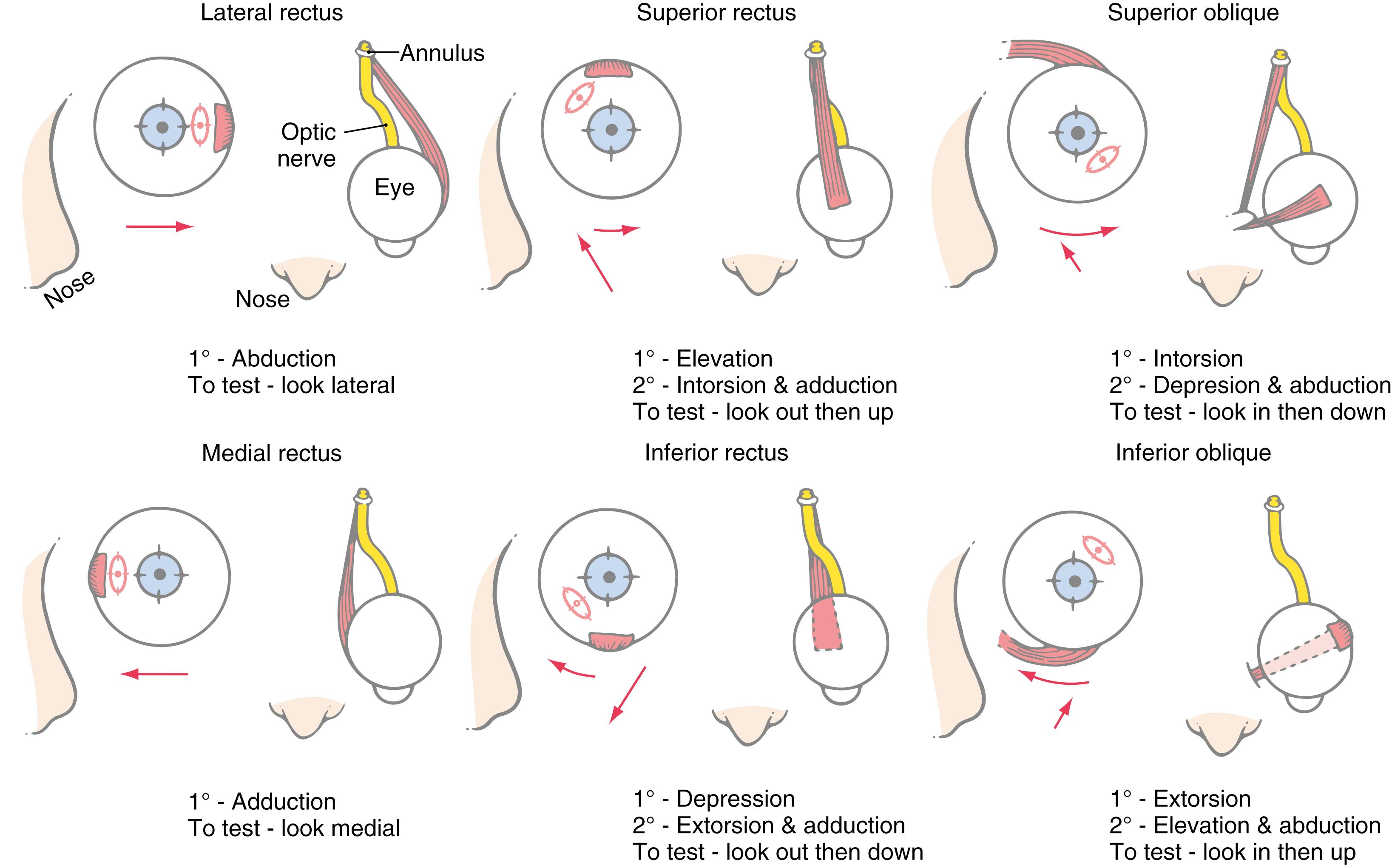
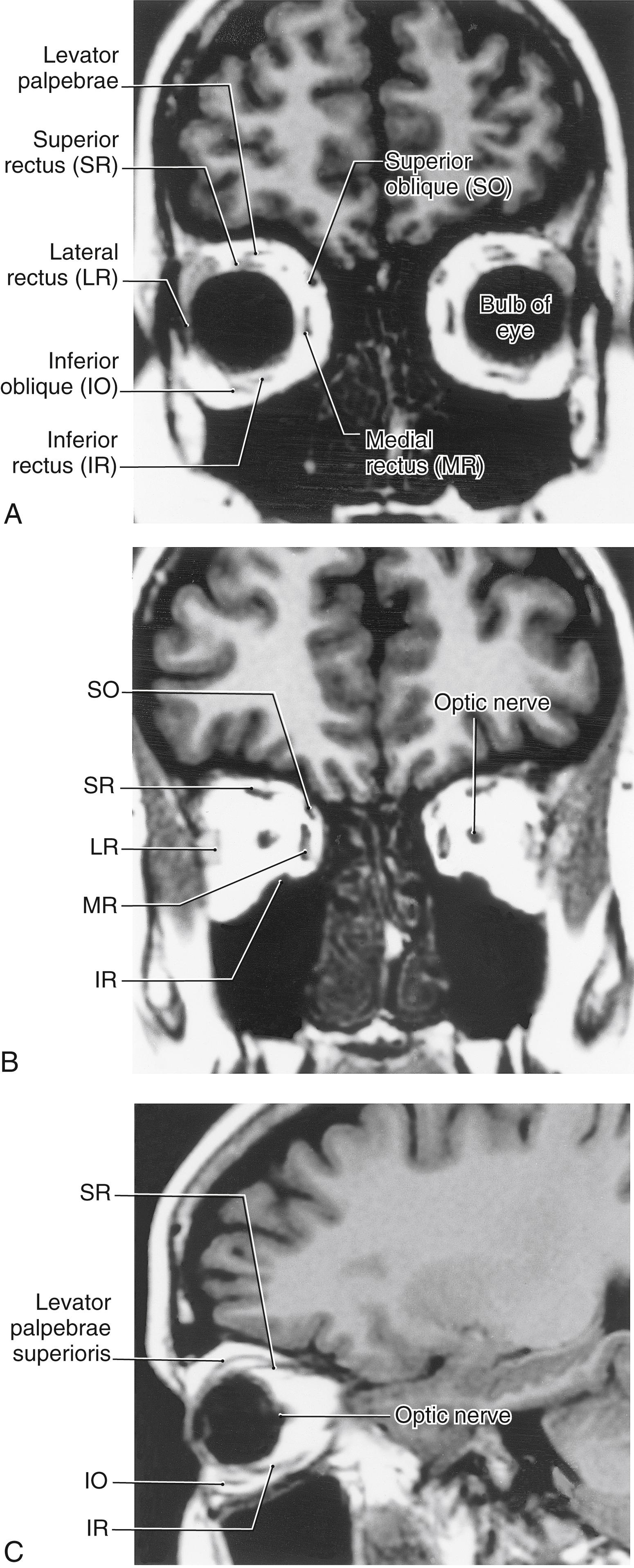
The extraocular muscles are supplied by three cranial nerves. The superior oblique muscle is innervated by the trochlear nerve; the lateral rectus muscle, by the abducens nerve; and the medial, superior, and inferior recti and inferior oblique muscles, by the oculomotor nerve. The formula (SO4 LR6) 3 (superior oblique 4, lateral rectus 6, all others 3) is a convenient memory aid for this pattern.
Extraocular muscles are striated and contain fibers adapted to produce extremely high contraction velocities and nearly constant tension. These muscles contain some of the smallest motor units in the body, giving them great precision of movement. The muscles run through connective tissue sheaths that act as pulleys controlling their pulling directions ( Fig. 28.3 ). Each muscle has an inner global layer and an outer orbital layer. The thick global layer inserts onto the sclera of the eye, whereas the thin orbital layer inserts into the connective tissue sheath to regulate the muscle’s pulling direction ( Fig. 28.3 ). Some forms of strabismus may be due to misaligned pulleys. The trigeminal nerve carries sensory information from the extraocular muscles. This proprioceptive signal appears to be critical for normal development of stereoscopic vision (perception of three-dimensional space) and may have other roles. However, visual feedback is the primary source of information revealing eye movement accuracy.
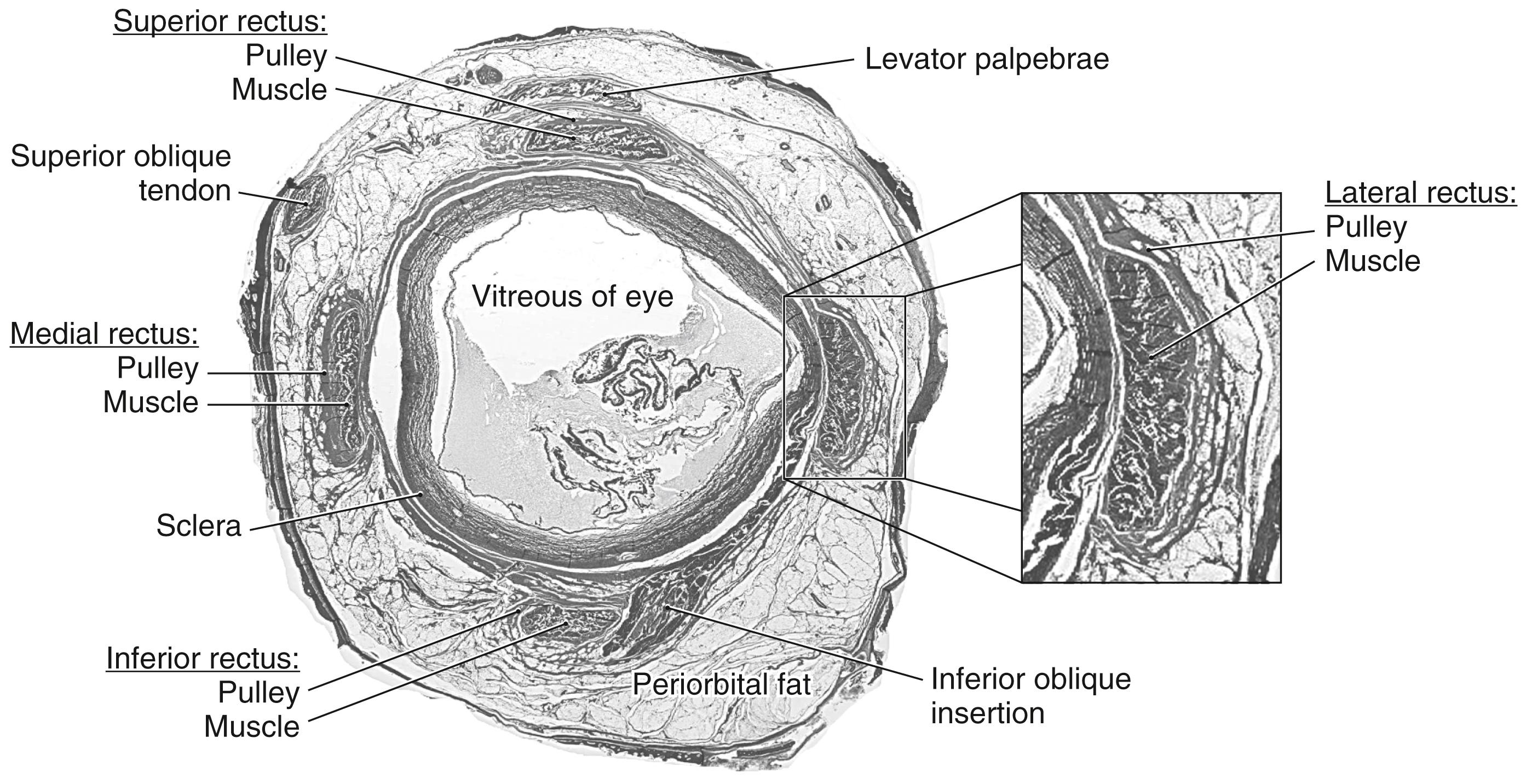
The eyes contain three intrinsic smooth muscles ( Fig. 28.4 ). The ciliary muscle changes the curvature of the lens to bring visual targets into focus on the retina. The sphincter (or constrictor ) pupillae muscle and dilator pupillae muscle control the size of the pupils in an antagonistic fashion to regulate the amount of light entering the eyes and the depth of field.
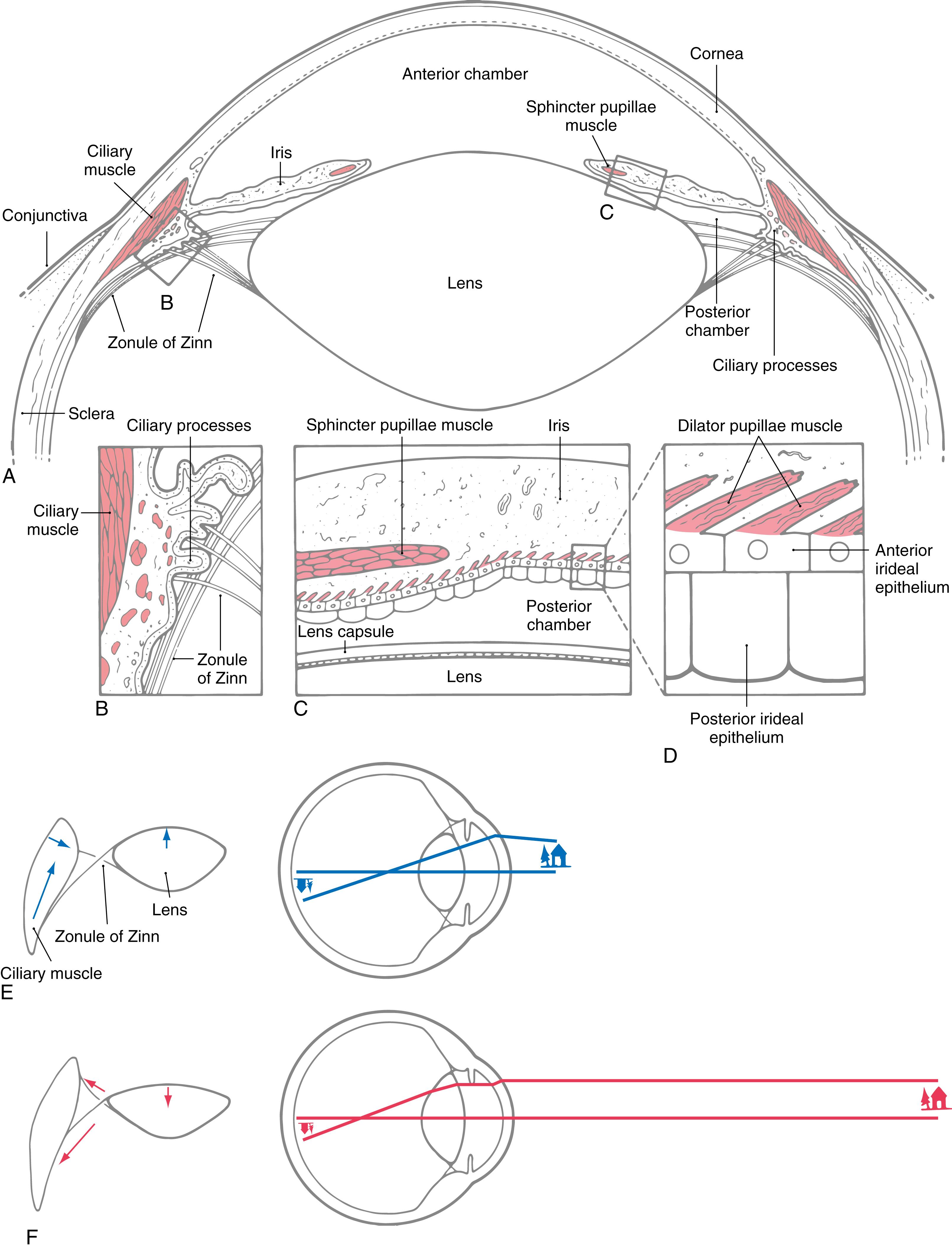
The ciliary muscle, found in the ciliary body, is connected to the lens by the suspensory ligaments ( zonule of Zinn ). These fine connective tissue threads resemble the spokes of a bicycle wheel. The action of the ciliary muscle changes the shape of the lens (via the zonule) to adjust its refractive state and focus the image on the retina ( Fig. 28.4 E, F ). These changes are termed lens accommodation. Constriction of the ciliary muscle is produced by activation of cholinergic postganglionic parasympathetic fibers from the ciliary ganglion. With age, the lens grows less elastic so that the actions of the ciliary muscle have less effect on refraction. This loss of accommodation produces a blurring of near vision termed presbyopia. Myopia, a loss of distant acuity, generally appears at an early age and may be due to genetic factors or overwork at close focal distances (e.g., reading).
The sphincter pupillae is a ring-shaped muscle that lies along the pupillary margin ( Fig. 28.4 A, C ). It contracts in response to activation of cholinergic parasympathetic fibers from the ciliary ganglion to constrict the pupil ( miosis ). The dilator muscle is radially arranged so that its action folds the iris and draws open the pupil ( mydriasis ). The dilator is activated by adrenergic postganglionic sympathetic fibers from the superior cervical ganglion.
The eyelid is controlled by the levator palpebrae superioris, the orbicularis oculi, and the tarsal or Müller muscles ( Fig. 28.5 ; see p. 418 ). The levator palpebrae is supplied by cranial nerve III. This muscle originates with and travels parallel to the superior rectus muscle, but continues forward to insert into the upper lid ( Fig. 28.2 A, C ). The levator holds the eyelid up when the eyes are open, and it functions in concert with the superior rectus, increasing the elevation of the lids, when the eyes look up. The orbicularis oculi, supplied by cranial nerve VII, closes the eyes by depressing the upper lid and elevating the lower lid. At the same time, co-contraction of the rectus muscles retracts the eye. The tarsal muscles are small smooth muscle slips at the edge of the bony orbit. They are supplied by postganglionic sympathetic fibers and help keep the lids open.
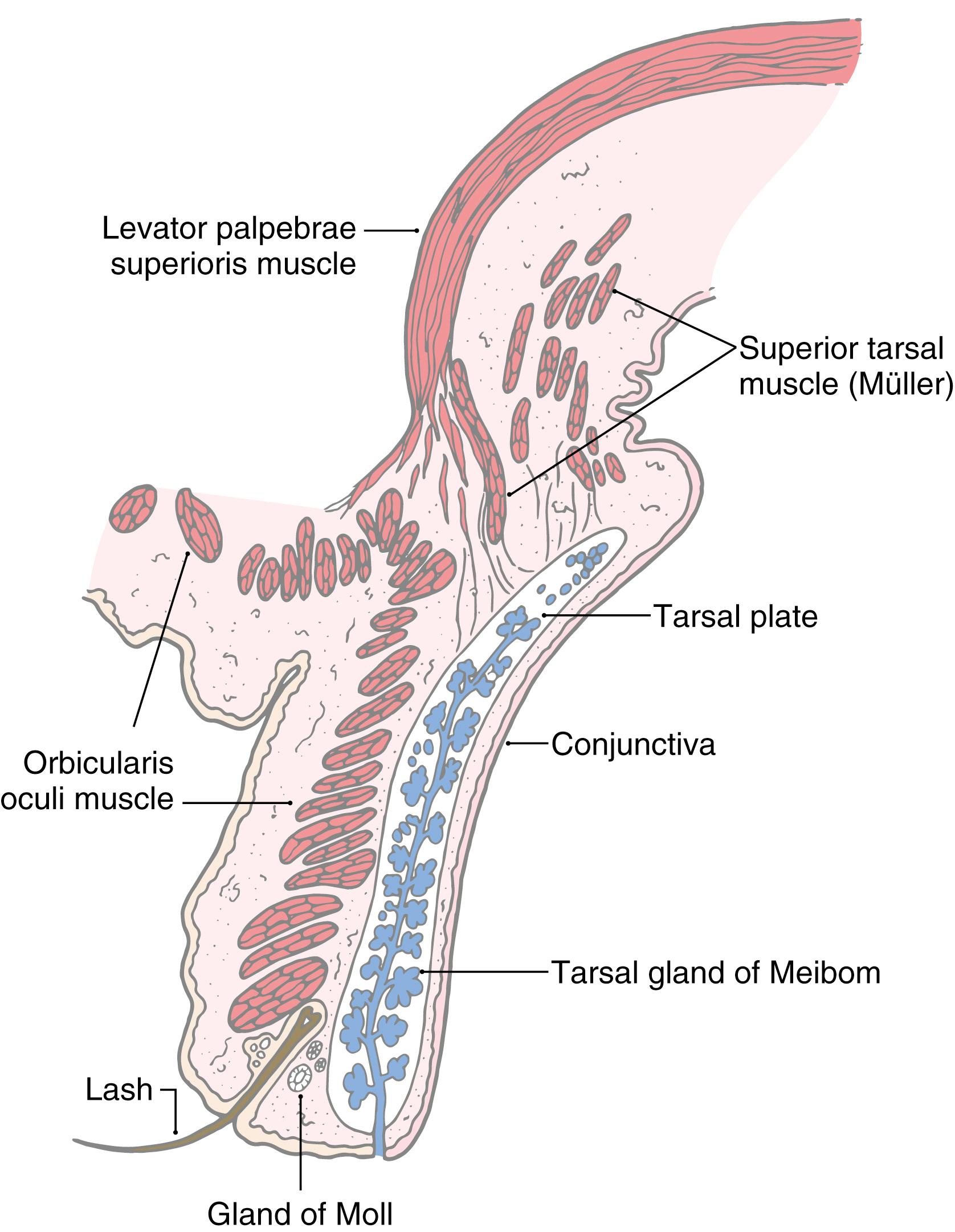
The oculomotor nucleus ( Fig. 28.6 A, B ; see p. 418 ) lies near the midline in the inferior part of the periaqueductal gray of the rostral midbrain. Beneath it lie the fibers of the medial longitudinal fasciculus, many of which synapse within the oculomotor nucleus. Axons from oculomotor motor neurons generally pass medial to the red nucleus and exit the midbrain just medial to the crus cerebri. These structures are supplied by paramedian branches of the basilar artery and the proximal part of the posterior cerebral artery (P 1 segment). Vascular lesions in this region produce oculomotor deficits in combination with other symptoms ( Table 28.2 ).

 |
The third cranial nerve passes along the wall of the cavernous sinus and enters the ipsilateral orbit by way of the superior orbital fissure. Its three branches supply the superior rectus and levator palpebrae muscles, the inferior rectus and inferior oblique muscles, and the medial rectus muscle. The motor neurons supplying each of these individual muscles form rostrocaudally oriented columns within the nucleus ( Fig. 28.7 ; see p. 420 ). The motor neurons supplying the levator palpebrae superioris muscle form a separate dorsal midline subnucleus called the caudal central subdivision.
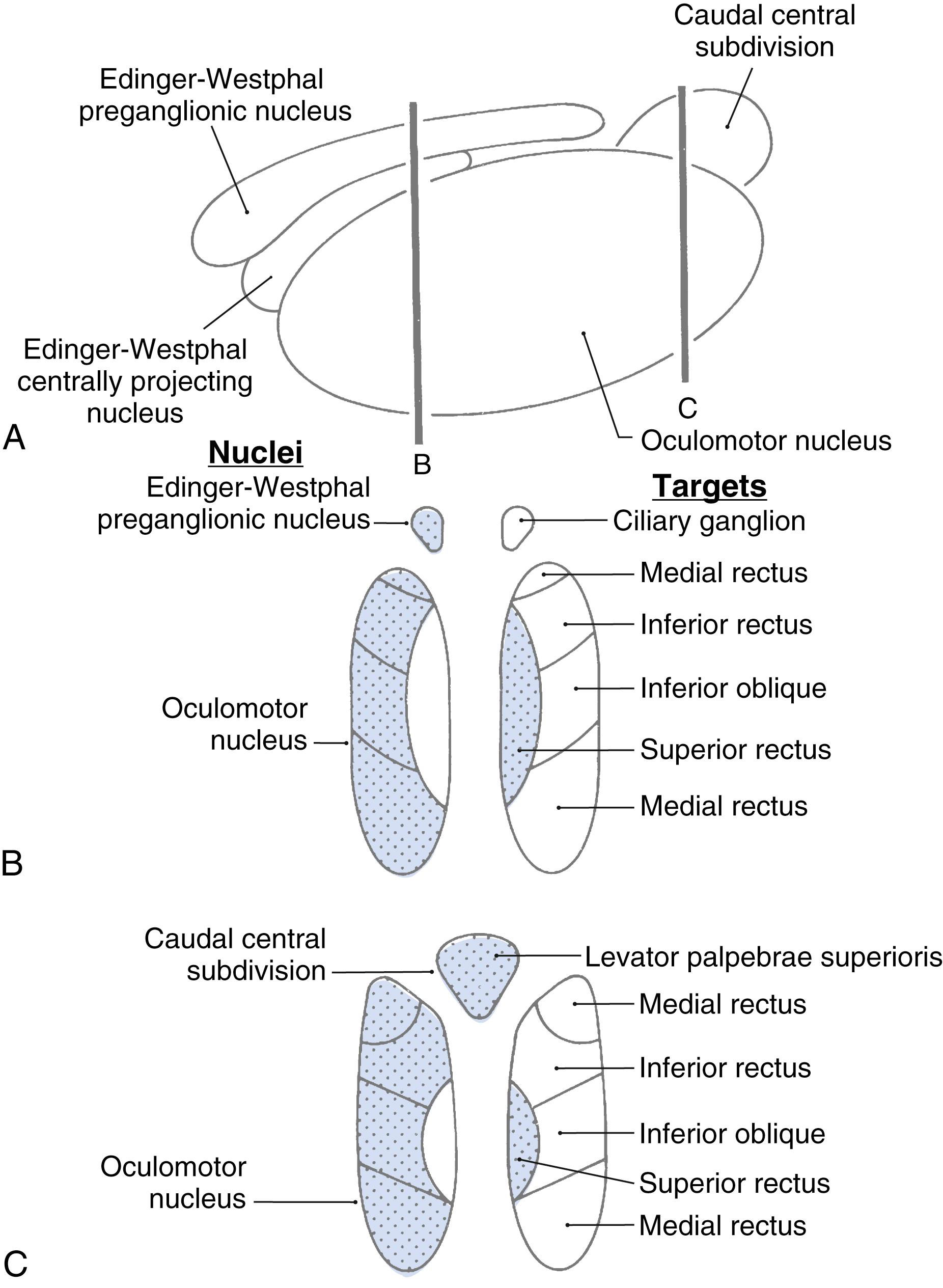
Become a Clinical Tree membership for Full access and enjoy Unlimited articles
If you are a member. Log in here